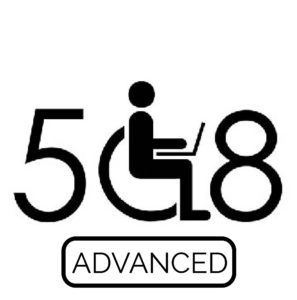Web Accessibility for Web Pages and Applications with WAI-ARIA, WCAG 2.0, and Section 508 Compliance Advanced Live Hands-On Instructor-Led Training Class
Virtual Online Live Training (VOLT™) Access from Anywhere
Outline & Course Information
 Duration & Times: 2 Days – 8:30AM-3:00PM EST
Duration & Times: 2 Days – 8:30AM-3:00PM EST
Locations for Training:
Course Description: In this hands-on, two-day Advanced Web Accessibility course, students take a deeper dive into modern techniques for web accessibility using WAI-ARIA, HTML5, and CSS. Students learn best practices for ARIA use to structure web pages, provide labelling and instructions, and adding accessibility to applications and widgets. The course also examines using accessible design patterns, how to develop a keyboard interface and control focus, and how ARIA works to provide accessibility to scripted elements. Students perform labs to fix accessibility issues in HTML and CSS, determine the correct ways to use ARIA, and add ARIA to code.
Please note that the recent (June 2018) addition of 17 success criteria found in WCAG 2.1 are briefly covered in this course. However, like AAA-level criterion, 2.1 updates currently are not included in legislation, and so receive less focus.
Prerequisites: Students should have taken the Introduction to Web Accessibility, WCAG 2.0, and Section 508 Compliance course or have an equivalent understanding of WCAG 2.0 A and AA requirements. Knowledge of HTML and CSS is essential. Familiarity with JavaScript is helpful, but not necessary. Students must have a good working knowledge of computers, operating systems, using a mouse, keyboard, standard menus and commands. Students must be able to open, save, and close applications and files, as well as navigate to other folders.
Required Technical Set-Up:
• Primary computer connected to a second monitor OR second computer to view instructor live
• Reliable High-speed internet connection
• Web Browser: Google Chrome Preferred (Alternative: Microsoft Edge)
• 3-Button Computer mouse
• Audio Speaker/Microphone (built-in to computer or external)
Job Roles That Use Web Accessibility:
Managers
Project teams
Web developers
Accessibility testers
Anyone who needs to learn about web accessibility, including the recent changes in Section 508 accessibility legislation, and how to make a website compliant
Anyone who need to create accessibility conformance claims, such as VPAT, and who need to create a strategy to maintain compliance
Projects That Use Web Accessibility:
Creating, assessing, remediating accessible Web pages
Planning and conducting accessibility review
Web Accessibility for Web Pages and Applications with WAI-ARIA, WCAG 2.0, and Section 508 Compliance Advanced Course Outline
1. Creating Semantic Markup and Structure with HTML5 and WAI-ARIA
This topic examines methods to use HTML5 and ARIA to create semantic markup and page structure.
2. Accessible Links, Forms, and Labelling
In this topic, students learn advanced labelling techniques using ARIA to enhance hyperlinks, instructions on web pages and forms, and other labelling issues.
3. Advanced Table Accessibility
In this topic, students learn HTML and ARIA techniques to address accessibility issues in complex tables, as well as in tables used for organizing forms, and how to make assistive technology ignore layout tables.
4. Advanced Form Accessibility
This topic addresses increasing accessibility in forms by ensuring that labels are programmatically associated with inputs and that like fields are grouped together. It also covers providing to the user in an accessible way any instructions and other information, such as required fields or expected data entry format.
5. Using WAI-ARIA for Accessibility in Widgets and Web Applications
Students take a deeper dive into using ARIA to improve accessibility by exploring best practices for using ARIA, as well as what to avoid doing. Using online resources, students explore accessible widget design patterns including using ARIA roles, states, and properties, and conventions for functionality and keyboard operability.
6. Controlling Focus and Functionality in Dialogs
This topic explores various approaches to the user experience and functionality in dialogs (“pop-up windows”), including controlling focus, keyboard interface expectations, and how to use ARIA to ensure vital information is passed to assistive technologies such as screen readers.
7. Using ARIA to Provide Feedback to Users
ARIA live regions and states are explored in a variety of circumstances to examine how ARIA can be programmatically changed with JavaScript in order to provide updates to assistive technologies about dynamic changes after the initial page load, for example, providing form validation errors or updating content. By studying working examples of ARIA used on dynamic web pages, students observe ARIA code updating in real time.
Labs
To reinforce and practice skills learned in the course, students use online tools to find the best ARIA solutions to remedy accessibility issues, perform written exercises in which they fix accessibility issues in HTML code, and add appropriate ARIA to HTML code for widgets.
Disclaimer: All course objectives and outlines are used as a guideline and are subject to change to ensure the latest information is covered to support real world use of the technology.
Software Versions: ThinkB!G open enrollment classes are taught on the most current version of software whenever possible. To request a specific version, please Contact Us or call us at 301-362-2250.
What You Get
- Instructor Led Hands-On Virtual Online Live Training (VOLT™) & Certification
- Training Delivered from Certified Instructors that are Senior Consultants
- Digital Official Curriculum Courseware (Not Used During Class) & Personal Use of Class Recording for Limited Time
- Certificate of Completion
- Remote Access to ThinkB!G Class Computer with Software licenses & Class Files Pre-Installed for Use During Training--No Installs or Downloads
- Instructor's Real-Time View of ThinkB!G Class Computer Screen for Immediate Live Interactive Support
- If Certification Training is Selected, It May Include a Test Prep Tool, Testing Voucher with Free Retake, and Proctor Fee (if taken with ThinkB!G Virtually)
- Note: IT Support is Available to Pre-Flight Virtual Class Set Up Before & During Training
Pricing
Public Enrollment Training Pricing
Commercial Price Per Person 2-Day Class: $795
GSA/Government Price Per Person 2-Day Class: $640.81
Non-Profit/Education Price Per Person 2-Day Class: $745
Need Private Custom Training for Your Team?
Dates to Register
| Event | Venue | Start Date | End Date | |
|---|---|---|---|---|
| Web 508 Accessibility Advanced | Web 508 Accessibility Virtual Classroom |
|
|
Learn More |
| Web 508 Accessibility Advanced | Web 508 Accessibility Virtual Classroom |
|
|
Learn More |
| Web 508 Accessibility Advanced | Web 508 Accessibility Virtual Classroom |
|
|
Learn More |
Custom Private Training
We offer this course as Custom Private Training or Project Based Training®!
If you have a team of individuals, you can receive bulk discounts by doing your own Private training session & cover your specific learning objectives!
What's Included?
- Custom Outline to include Targeted Topics Based on Your Learning Needs
- Instructor Led Hands-On Virtual Online Live Training (VOLT™) & Certification
- Training Delivered from Certified Instructors that are Senior Consultants
- Official Curriculum Courseware & Personal Use of Class Recording for Limited Time
- Certificate of Completion
- Remote Access to ThinkB!G Class Computer with Software licenses & Class Files Pre-Installed for Use During Training--No Installs or Downloads
- Instructor's Real-Time View of ThinkB!G Class Computer Screen for Immediate Live Interactive Support
- If Certification Training is Selected, It May Include a Test Prep Tool, Testing Voucher with Free Retake, and Proctor Fee (if taken with ThinkB!G Virtually)
- Note: IT Support is Available to Pre-Flight Virtual Class Set Up Before & During Training
Submit details and a formal training quote will be sent to you!
Policies
Payment Policy for Public Enrollment Classes
Payment and/or Purchase Order is required 16 Business Days (Monday-Friday) prior to first date of training class.
Payment Policy for Private & Project Based Training® Classes
Payment and/or Purchase Order is required 16 Business Days (Monday-Friday) prior to first date of training service. Pricing provided is firm fixed price based on number of students. Client is responsible for entire amount regardless of change in number of registrations.
Cancellation/Rescheduling Policy for Public Enrollment Classes
- Classes may be canceled if less than 4 students are registered. We will notify you of cancellations no later than 16 business days prior to class.
- Canceling/Rescheduling more than 16 business days prior to class: You are eligible for a refund or free reschedule. Registration is transferable to another student for the same class & date.
- Canceling/Rescheduling less than 16 business days prior to class: No refund. No Reschedule. Registration is transferable to another student for the same class & date.
- No Shows without contact: No refund. No Reschedule.
Cancellation/Rescheduling Policy for Custom/Private and On-Site Training Classes
- No penalty if cancellation/reschedule is 16 Business Days (Monday-Friday) prior to the first date of class.
- 50% penalty will be incurred if cancellation/reschedule is less than 16 Business Days (Monday-Friday) prior to the first date of class. This fee is to cover instructor expenses, travel, and course materials purchased.
Cancellation/Rescheduling Policy for Individual Students in Custom/Private Training Classes
- Individual students registered in a private class, who cancel or do not show, are not eligible for a partial refund or reschedule. Registration is transferable to another student. Please contact your class organizer or manager if you need to cancel.
Reviews
Average Review: 4.5 out of 5 - 4 Reviews
Keep Doing What You Are Doing!

Think BIG Is A Great Way To Enhance Computer Skills!

It is an Extremely Valuable Resource to Have.










